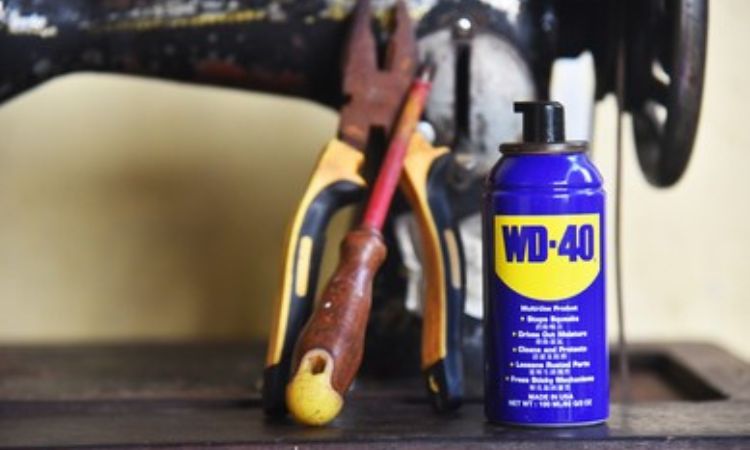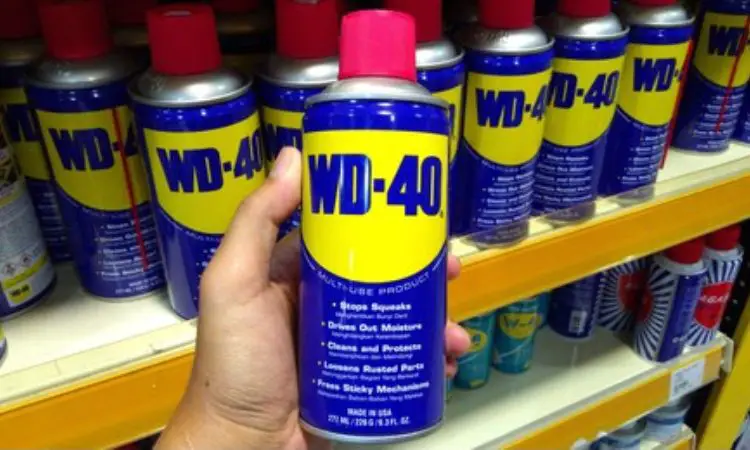It’s a usual scenario for many people to struggle with rust and corrosion on powder coatings. You are not alone if it troubles you quite often. You might consider using WD 40 as a solvent to eliminate this issue.
So, a question may be roaming around your head, should I use WD 40 on powder coat?
WD 40 is not designed for application on powder coating. Because this kind of solvent can dissolve the powder coating due to its heavy chemical components. You must avoid WD-40 on the powder coat. However, if it accidentally happens, wipe it off before it turns gummy or peels off the surface.
The answer doesn’t end here. The whole matter is a delicate thing. So move forward to know each detail, starting with the purposes of WD-40.
What Are the Purposes of WD 40
WD 40 is a lubricant and solvent mixture made from petroleum. It comes in a spray can, which can be used on metal surfaces. It assists in dissolving rust and corrosion. Also, it provides a thin layer that helps to prevent rust and other forms of deterioration.
Wd 40 penetrates and lubricates tight spaces and hard-to-reach places very well. In fact, it is a versatile product that is widely used for a variety of purposes. Let’s get to know the purposes in a broad manner.
Cleaning:
A great way to remove dirt, stains, and other contaminants from metal surfaces is to use WD-40. You can easily remove the corrosion and rust by simply using WD-40.
Lubrication:
A WD 40 solution can be used to lubricate moving parts. In fact, it is greatly used to remove friction and wear. Moreover, it protects metal surfaces from corrosion and provides a safety coating over the surfaces.
Protection:
Moisture and other forms of corrosion can be prevented by using WD 40. And it is considered one of the most significant features of WD 40. In addition to protecting your surfaces, it provides a thin shielding layer.
Flexibility:
Several surfaces (e.g., metal, plastic, and wood) can be treated with WD-40. Moreover, hard-to-reach places can be easily reached with it because it is an aerosol spray that can be sprayed from any angle. Afterward, you can apply it using a thin, long nozzle for precise coverage.
Can WD 40 Be Used on Powder Coat
WD 40 is a penetrating oil and water-dispersing spray. This particular spray is designed to dissolve rust and corrosion. Generally, WD 40 is not suitable for use on powder coat surfaces.
Because it can damage or discolor the powder coat if you spray WD-40. The intensive petroleum-based chemicals in WD 40 mainly lead to damage.
If you want to use WD 40 to clean and lubricate powder-coated surfaces, it’s better not to use it. Since it’s not particularly designed for use on powder-coated surfaces. Nonetheless, it is good for cleaning car windshields.
You must use products that are specially made for use on powder coats. Many products are designed to be safe for powder-coated surfaces and won’t damage or discolor them.
Therefore, it is important to test any cleaning or lubricating product in a concealed area before applying it to a larger surface.
How to Use WD 40 on Powder Coat
Usually, WD 40 is not recommended to use on a powder coat since it tends to damage the coating. If you still want to use WD 40 on powder-coated surfaces. You should follow the method given below.
To use WD 40 on a powder coat, the following pieces of equipment are needed to perform the job.
Equipment: A soft cloth and a soft brush.
Now moving towards the stepwise process of using WD 40 on the powder coat.
Step one: First, verify the compatibility by testing the WD 40 on a small, inconspicuous area that is powder coated. If WD 40 doesn’t cause any damage or discoloration, you may proceed to the next step.
Step two: You need to clean the external dirt and other contaminations from the surfaces where you want to use WD 40. A soft brush can be used for performing this cleaning job.
Step three: Now shake the WD 40 very well before spraying. Then, apply WD 40 by spraying a light mist over the surface while holding the can approximately six inches away.
Step four: Using a cloth or brush, you need to wipe the WD 40 into the surface. Then wipe off the excess WD 40 with a clean, dry cloth. It is recommended not to use too much WD 40 as this can oversaturate the surface and lead to potential surface damage.
Whenever you are using a cleaning or lubricating product like WD 40, exercising some caution is mandatory.
What Are the Precautions for Safely Handling WD 40
Since WD-40 is a chemical solvent, you must handle it with some safety measures. Otherwise, an accident can happen. Here are some precautions to follow when using WD 40.
You shouldn’t ignore to follow precautions while handling WD 40. Because at any moment, the situation can worsen.
What Are the Advantages & Disadvantages of Using WD 40 on Powder Coat
The use of WD 40 comes with both good and bad sides, like any other solution. Let’s shed light on the positive side first.
Advantages:
The benefits of WD 40 are extensive and very significant. In this section, we will discuss them.
Disadvantages:
The pitfalls are not unusual if you use WD 40 on a regular basis. It can also produce some unsatisfactory results, like any other chemical product.
What Are the Alternatives to Using WD 40 on Powder Coat
Since using WD 40 on a powder coat is not a good idea, it is urgent to figure out some fruitful alternatives. Here, I’ve pointed out some excellent alternatives to using WD 40 on powder-coated surfaces.
A Mild Detergent:
When cleaning powder-coated surfaces, it’s better to use mild detergent and water rather than WD 40. It will remove the dirt from the surface without harming the powder coating. Homemade water deionizer is also an amazing addition instead of normal water.
Graphite or PTFE Spray:
Dry lubricants like graphite or PTFE spray are perfect as an alternative to WD 40. The lubricant leaves no residue on the surface. You can easily reduce the friction and wear on the surface.
However, it is less effective in preventing corrosion and rust than silicone-based lubricants.
Penetrating Oil:
You can use penetrating oil instead of using WD 40 to remove rust. Also, stuck parts can be loosened by using penetrating oil or lubricant. It provides great protection against corrosion.
Basically, it’s designed to loosen up the stuck parts but can’t provide better lubrication like silicone or dry lubricants.
Silicone Spray:
It’s a silicon-based spray that lubricates powder-coated surfaces wonderfully. This is also great for protecting the surface from unwanted rust and corrosion. It will also remove fingerprints that do not come off your car.
To protect powder-coated surfaces, WD 40 should never be used. Powder-coated materials can be cleaned, lubricated, or protected using any of the alternatives described above for a better result.
Frequently Asked Questions (FAQs)
Does WD 40 damage paint?
WD 40 won’t ruin your paint. However, try not to apply it directly on the surface. If you get it applied on a painted surface, try to wipe it off quickly. Because the longer the product remains on the surface, the more the chances of damage increase.
Will WD 40 stop rust from spreading?
Yes, WD 40 works to prevent rust from spreading further. Also, a thin layer of protection is applied to your object. Furthermore, it penetrates deep into the small areas and prevents further oxidation.
Can you powder coat twice?
Obviously, you can powder coat twice because powder coating doesn’t make your material incompatible with another powder coating. Coatings can still be applied to make them look new.
Conclusion
Hopefully, this article, WD 40 on powder coat, adequately answered all your questions.
WD 40 is great for removing rust and corrosion but sometimes can be harmful to powder coating due to its chemical properties. You should use the alternatives if your concern is removing dirt and grime.
I am signing off here. Have a great day.
As an Amazon Associate I earn from qualifying purchases.





